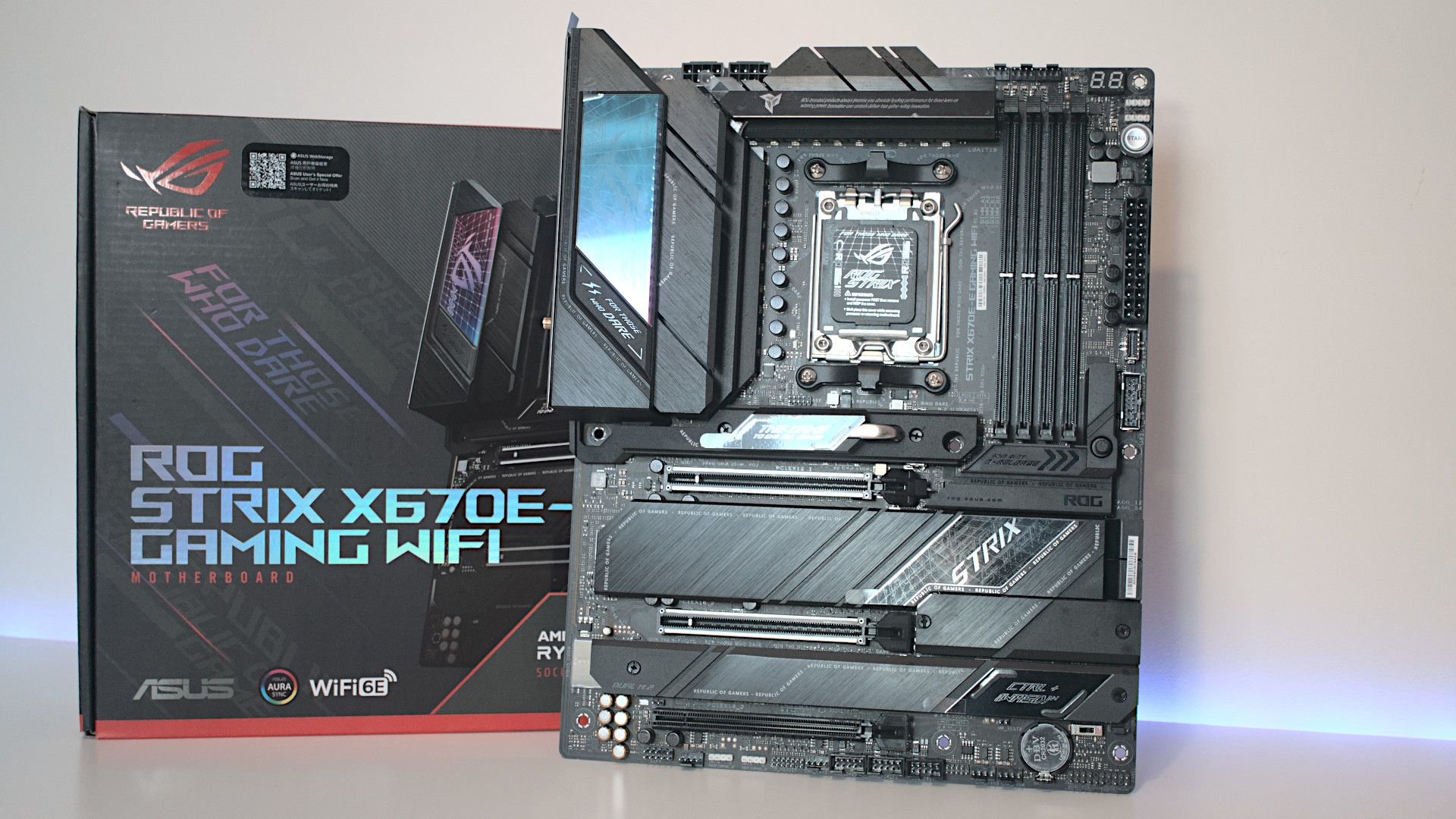AMD's Ryzen 7000 series of processors make use of the company's newer AM5 socket, replacing the older AM4 socket used by the first wave of Ryzen chips. Utilizing the best DDR5 RAM, PCIe 5.0, and USB 4.0, there's plenty to appreciate with the 7000 series of processors. When shopping around for an AM5 motherboard, there are a few chipsets to choose from. I'll showcase some of the best motherboards available for AMD chips to aid you in building the PC of your dreams.
My picks for the best AM5 motherboards in 2024
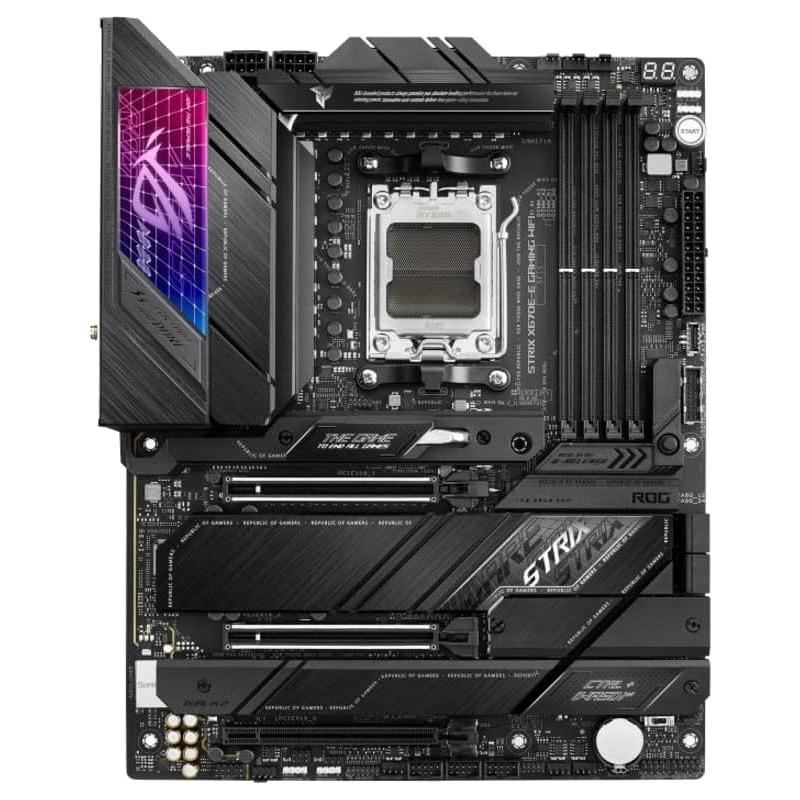
Asus ROG Strix X670E-E Gaming
The best AM5 motherboard for gamers and most users
The Asus ROG Strix X670E-E Gaming is a high-end Asus motherboard that supports PCIe 5.0 graphics, three PCIe 5.0 SSDs, and high-end Ryzen 7000 CPUs thanks to its large 18+2 stage VRM.
- PCIe 5.0 for GPUs and SSDs
- Large 18+2 stage VRM
- Support for 6400MHz DDR5
- Expensive and overkill for gaming
The Asus ROG Strix X670E-E Gaming is one of the best motherboards you can buy for Ryzen 7000. For starters, it comes with a plethora of PCIe x16 and M.2 slots, but what sets this board apart from the rest is that most of these run at PCIe 5.0 speeds (two of the x16 and three of the M.2 slots). That's a ton of PCIe 5.0 even for an X670E, most of which offer just two PCIe 5.0 M.2 ports for SSDs. The Strix also has an 18+2 stage design for its VRMs, which is more than enough even for the highest-end Ryzen 9 7950X, and support for DDR5-6600.
This board doesn't skimp out on the boring stuff either. The Strix has eight fan headers, an error code display, SSD heatsinks, and an obscene number of front-facing USB ports. The rear I/O also has a ton of USB ports: 12 USB 3.2 Gen 2 and one 3.2 Gen 2x2. The Ethernet on the Strix is Intel's 2.5 gigabit, which isn't the fastest, but it's still a good amount for gamers and even content creators, not to mention that Intel's Ethernet NICs are usually the best. The five audio jacks plus optical audio might also be appealing if you're into that sort of thing.
Even if you don't care too much about the technical specs, there's one thing to appreciate: this board looks great. The Strix has that classic dark black plus RGB aesthetic and doesn't come with an obnoxious amount of branding. The Strix's design lends itself to fit in with a wide variety of themes. In my extensive testing with the ROG Strix X670E-E, the AMD Ryzen 9 7950X ran extremely well with plenty of room for overclocking not only the processor, but also the RAM, and other components. It's a joy to use.
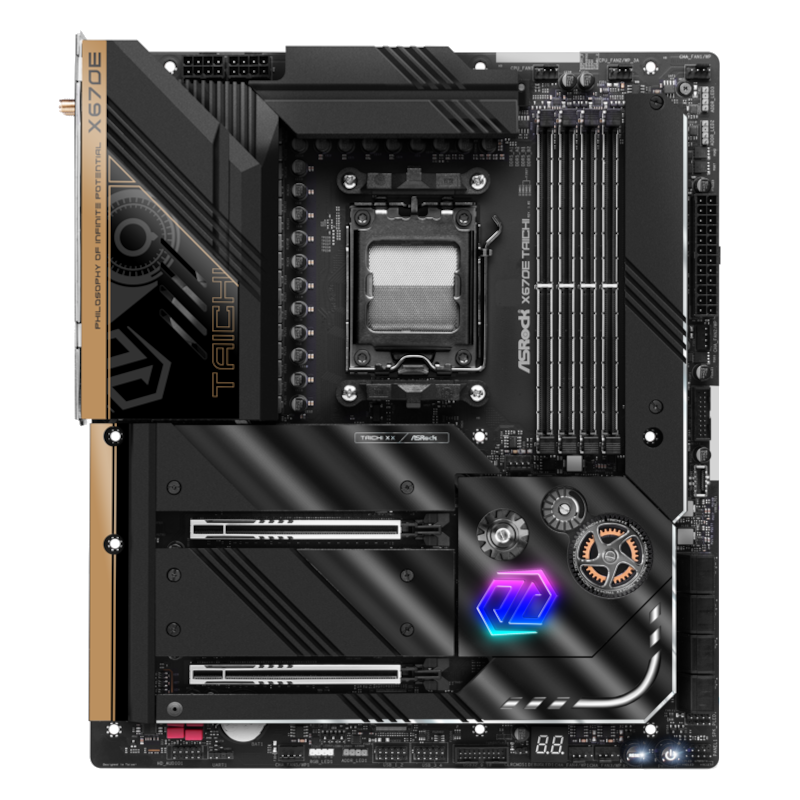
ASRock X670E Taichi Support Gaming Motherboard
A good alternative if you're okay with EATX and need more VRMs
The ASRock X670E Taichi is a high-end EATX motherboard with excellent build quality and a massive 24-stage VRM. It has support for high-speed DDR5 memory, PCIe 5.0 graphics, and multiple NVME SSDs.
- Support for PCIe 5.0 SSDs and GPUs
- Top-end 24+2+1 stage VRM
- Supports 6600MHz DDR5
- Expensive and overkill for gaming
- EATX size requires a large chassis
ASRock has been a long-time challenger to Asus, and its X670E Taichi does have some advantages over the Strix X670E-E. For starters, it has a much larger VRM configuration at 24+2 stages, which is significantly more than the Strix's 18+2. The rear panel I/O includes two USB4 ports, something the Strix has zero of. It also matches Asus on DDR5 support, dual PCIe 5.0 x16 slots, Intel 2.5 gigabit Ethernet, and also comes with eight SATA ports instead of four (though that's of questionable value).
The Taichi falls a little behind in some other aspects, however. It only has one M.2 slot running at PCIe 5.0, with the other three at PCIe 4.0. There are fewer USB ports on the rear panel I/O and some of them run at 3.2 Gen 1 speeds rather than 3.2 Gen 2. That the Taichi is EATX-sized rather than ATX also might pose a problem for chassis compatibility. Finally, the aesthetic of the Taichi is similar to the Strix but has a few questionable spots; the gold accent on the left side of the board might clash with some colors, and you'll have to decide whether you like the stylistic gears.
Overall, this motherboard is a worthwhile alternative to the Strix, even if it falls short in a few areas. But for overclocking, it is theoretically the superior choice given its larger VRM, so if you plan on overclocking your Ryzen 7000 for fun or to get a serious boost in performance, the Taichi might be the better choice. Id' recommend this motherboard for enthusiasts and those with deep pockets who want the very best the AMD X670E platform has to offer.
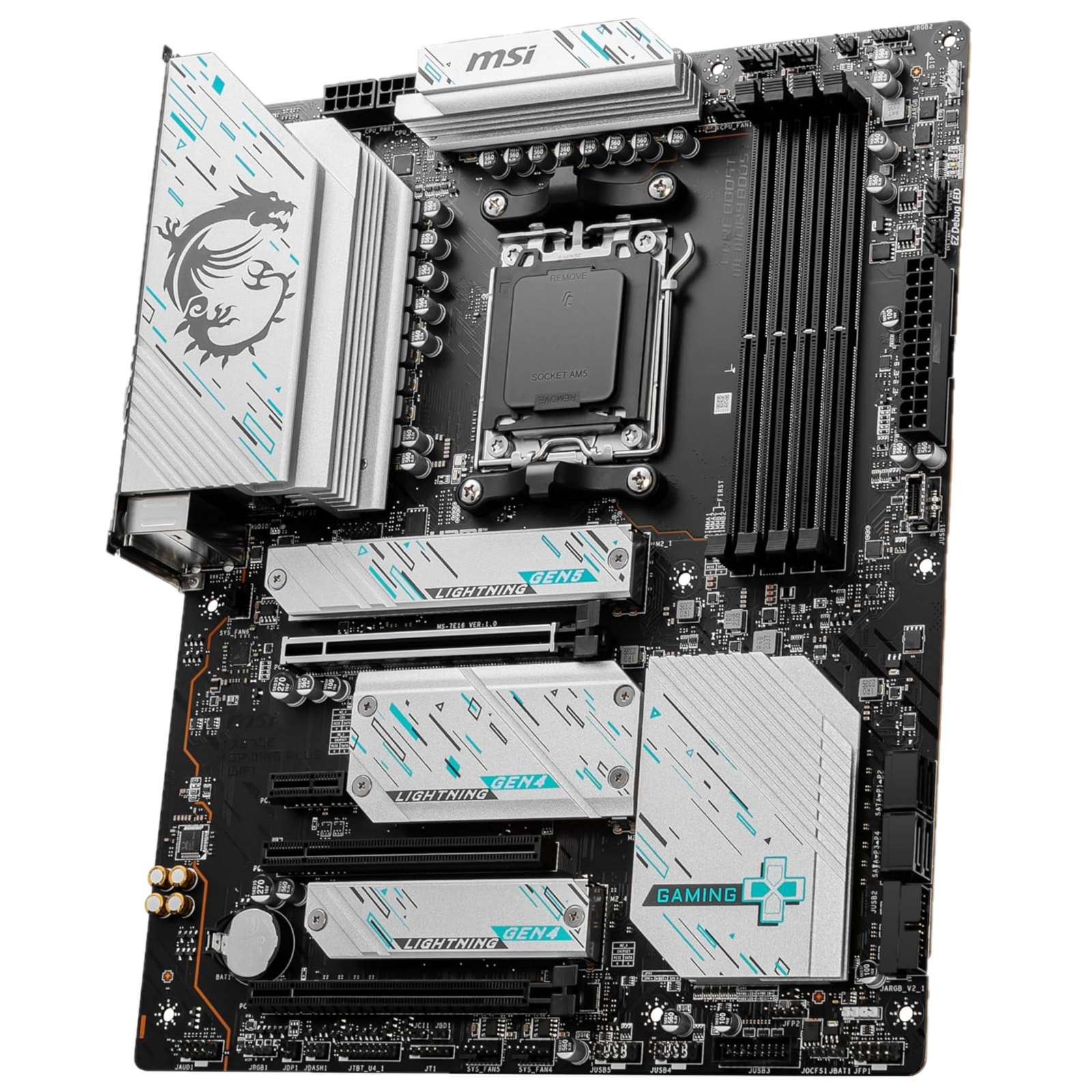
MSI X670E Gaming Plus WiFi
An X670 with value rivaling many B650 boards
The MSI X670E Gaming Plus WiFi is an excellent board for any AM5 PC, thanks to a premium construction and next-gen features.
- PCIe 5.0 support for SSDs, plus three more PCIe 4.0 M.2 SSD slots
- Decently sized 14+2+1 stage VRM
- Insanely cheap for what you get
- Realtek Ethernet only
- No PCIe 5.0 for GPUs
The AMD X670 chipset is not one which you'd expect to find value, but believe it or not, one of the best bang for the buck AM5 boards uses this higher-end chipset. MSI's X670E Gaming Plus WiFi used to cost a fair chunk of change, but now with its discount, it's as cheap as many B650 motherboards while having a ton of features. There are two great features of the MSI X670E Gaming. Firstly, it has four M.2 slots for SSDs, which is more than enough for anyone, and one of these slots even supports PCIe 5.0 SSDs.
This board also has a 14+2+1 stage VRM, which should just barely be enough for a Ryzen 9 7950X and more than enough for any lower-power CPU. Its rear I/O is also fairly good, coming with eight USB slots, 2.5 gigabit Ethernet, and Wi-Fi 6E. For $200, this is a pretty great motherboard. As long as the MSI X670E Gaming Plus WiFi stays at this price, it's by far the best X670 motherboard for the value. The X670E Gaming Plus WiFi doesn't just get the balance between pricing and features right; it's just so cheap for what it is.
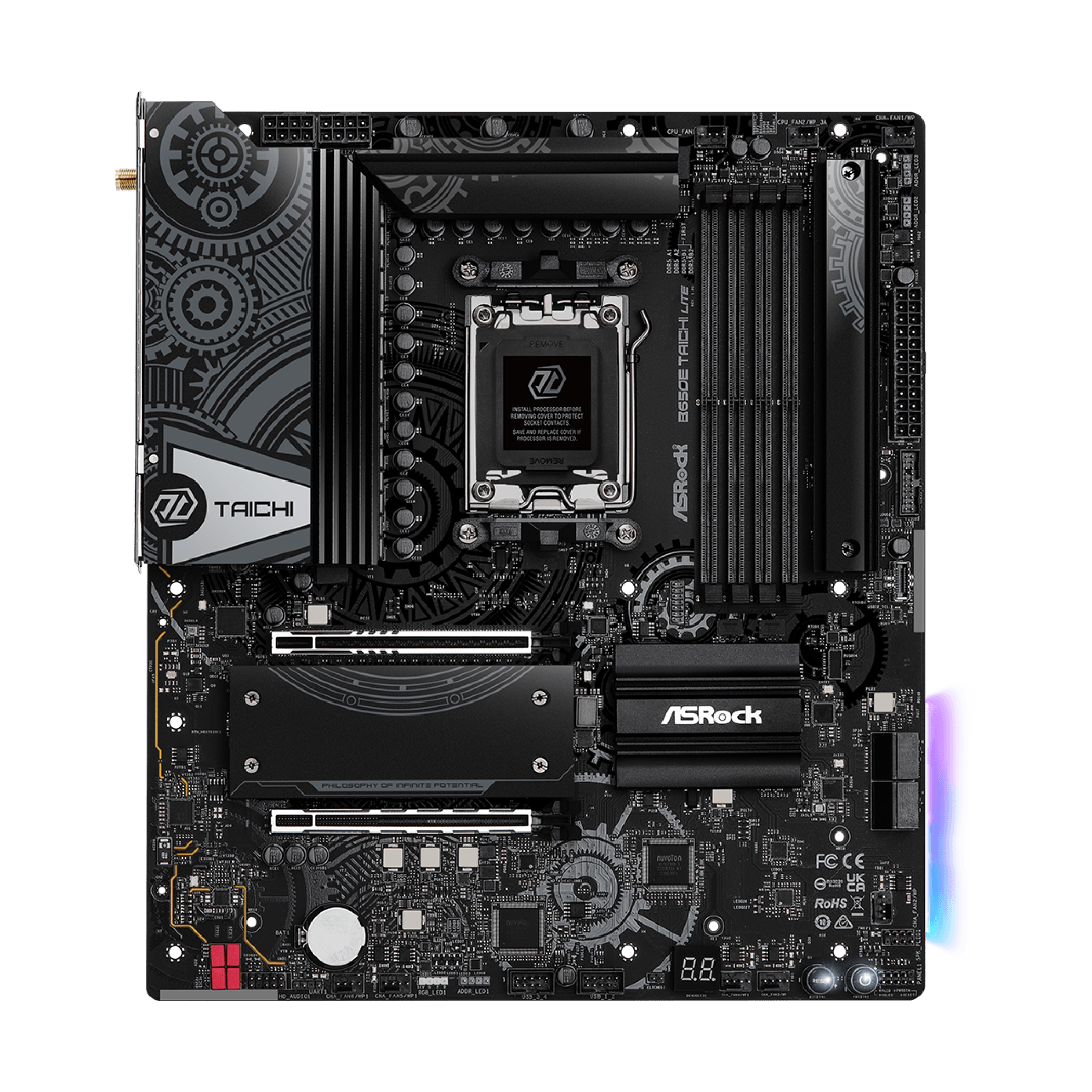
ASRock B650E Taichi Lite
The best motherboard for AMD's strangest chipset
ASRock's B650E Taichi Lite is a midrange AM5 motherboard that offers an impressive spec list for a relatively low price. It comes with a massive 24+2+1 stage VRM, PCIe 5.0 support for SSDs and GPUs, and tons of USB 3.2 ports.
- Completely overkill 24+2+1 stage VRM
- Three M.2 slots for NVMe SSDs, one of which has PCIe 5.0 support
- Tons of USB 3.2 ports
- Low supply
The B650E is a premium mid-range chip, sitting just below the X670. It comes with the same PCIe 5.0 support for GPUs and SSDs, which makes it almost as good as the X670. Cheaper X670 boards are about the same price as B650E motherboards, which can make it confusing to figure out if B650E is worth it, but ASRock's B650E Taichi Lite is a pretty good motherboard regardless of the chipset. The specs for the B650E Taichi Lite are excellent for a motherboard that costs just shy of $300. It has an overkill 24+2+1 stage VRM, one PCIe 5.0 M.2 slot in addition to two more PCIe 4.0 M.2 slots, 12 USB 3.2 ports, and Intel Ethernet and Wi-Fi.
These specs are more appropriate for an X670 or even X670E motherboard, but for some reason, ASRock put them on a mid-range B650E motherboard. If it weren't for the B650E Taichi Lite, the B650E would have had a hard time justifying its own existence. It's designed for those who need something more from their AMD chip without spending a fortune on a X670E motherboard. The B650E Taichi Lite is a great-looking motherboard that has pretty much everything you could ask for. If you can find one, it'll be perfect to pair with a mid-range or even high-end PC.
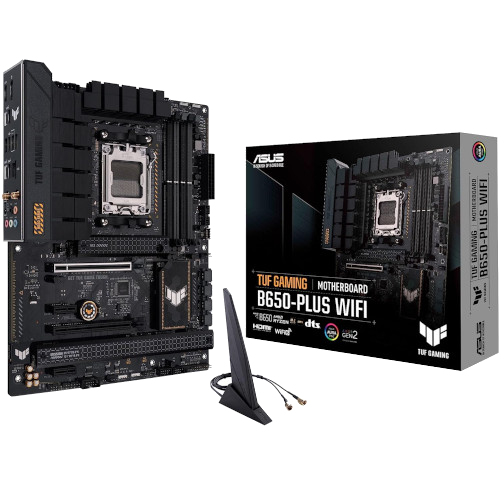
Asus TUF Gaming B650-Plus
A midrange motherboard with lots of features at just the right price
The Asus TUF Gaming B650-Plus is a midrange motherboard with support for PCIe 5.0 SSDs and midrange to high-end Ryzen 7000 CPUs.
- PCIe 5.0 SSD support, plus two PCIe 4.0 slots
- Midrange 12+2 stage VRM
- Robust rear I/O port selection
- Some features may be superfluous depending on your needs
B650 motherboards have just the gaming and productivity essentials but can still have features that are about on par with higher-end boards with better chipsets such as the B650E and X670 series. This motherboard is ideal for those starting with a mid-range PC and upgrading it over time to become high-end without needing to swap out the motherboard. The TUF Gaming B650-Plus carries a remarkable number of features for its price. Three M.2 slots for NVMe SSDs, one of which is PCIe 5.0 enabled, are joined by a 12+2 stage VRM, Wi-Fi 6E, 2.5 gigabit Ethernet, and lots of USB ports.
There are lots of motherboards that have some of these features or even higher quality features like bigger VRMs, but no other B650 motherboard that I know of hits all of these points at once, making it easy to recommend to anyone. The only drawback of the TUF Gaming B650-Plus is that it's a tad more expensive than other models, mostly owing to all its features, and not all of them are super useful. ASRock's B650 PG Lightning is a slightly cheaper and lower-end motherboard that has one less PCIe 4.0 M.2 slot but a larger VRM, which might be more appealing if you're after raw performance.
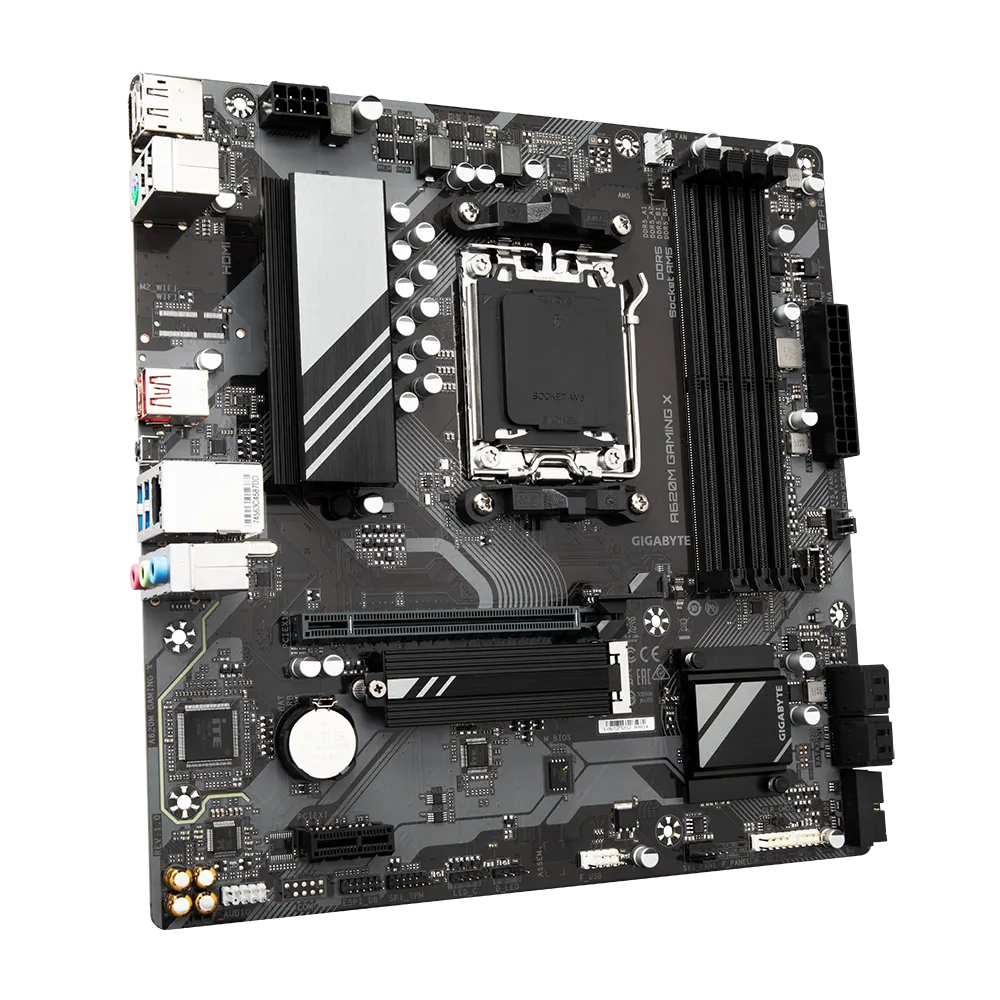
Gigabyte A620M Gaming X
Finally, AM5 for less than $125
Gigabyte's A620M Gaming X is a low-end AM5 motherboard that's ideal to pair with midrange Ryzen chips like the Ryzen 5 7600. It sports an 8+2+1 stage VRM, has four RAM slots, and has one M.2 slot with PCIe 4.0 support.
- Much cheaper than B650 motherboards
- 8+2+1 stage VRM is sufficient for non-X CPUs and the 7800X3D
- PCIe 4.0
- Just one M.2 slot
- Rear I/O is paltry
- More expensive than other A620 boards
The A620 chipset is the entry-level offering from AMD for Ryzen 7000 processors. While these motherboards are supposed to go with low-end Ryzen CPUs, you could get one for a mid-range chip instead. You could even use a Ryzen 9 chip, though I'd recommend doing so with my experience of using such motherboards. The Gigabyte A620M Gaming X is modest but sufficient when it comes to features. It has a decent 8+2+1 stage VRM with a heatsink, and it should be enough for non-X SKUs and probably also the 7600X, 7700X, and 7800X3D.
There's also four RAM slots, which you probably won't populate completely, but it's nice to have the option. It only has one PCIe 4.0 M.2 slot for NVMe SSDs, though honestly, if you only have $100 or so for a motherboard, you might not be looking to buy more than one M.2 SSD anyway. The rear I/O is also decent, with four USB 3.2 and two USB 2.0 ports (one of which is USB Type-C), as well as gigabit Ethernet. Other A620 boards like MSI's PRO A620M-E are mostly the same and a little cheaper, but I prefer Gigabyte's board since its VRM setup is a tiny bit bigger and has a heatsink, whereas most other A620 boards have fewer VRMs and no heatsink.
This is a good buy if you're looking to save as much as possible yet be able to utilize DDR5 RAM and the latest hardware from AMD.
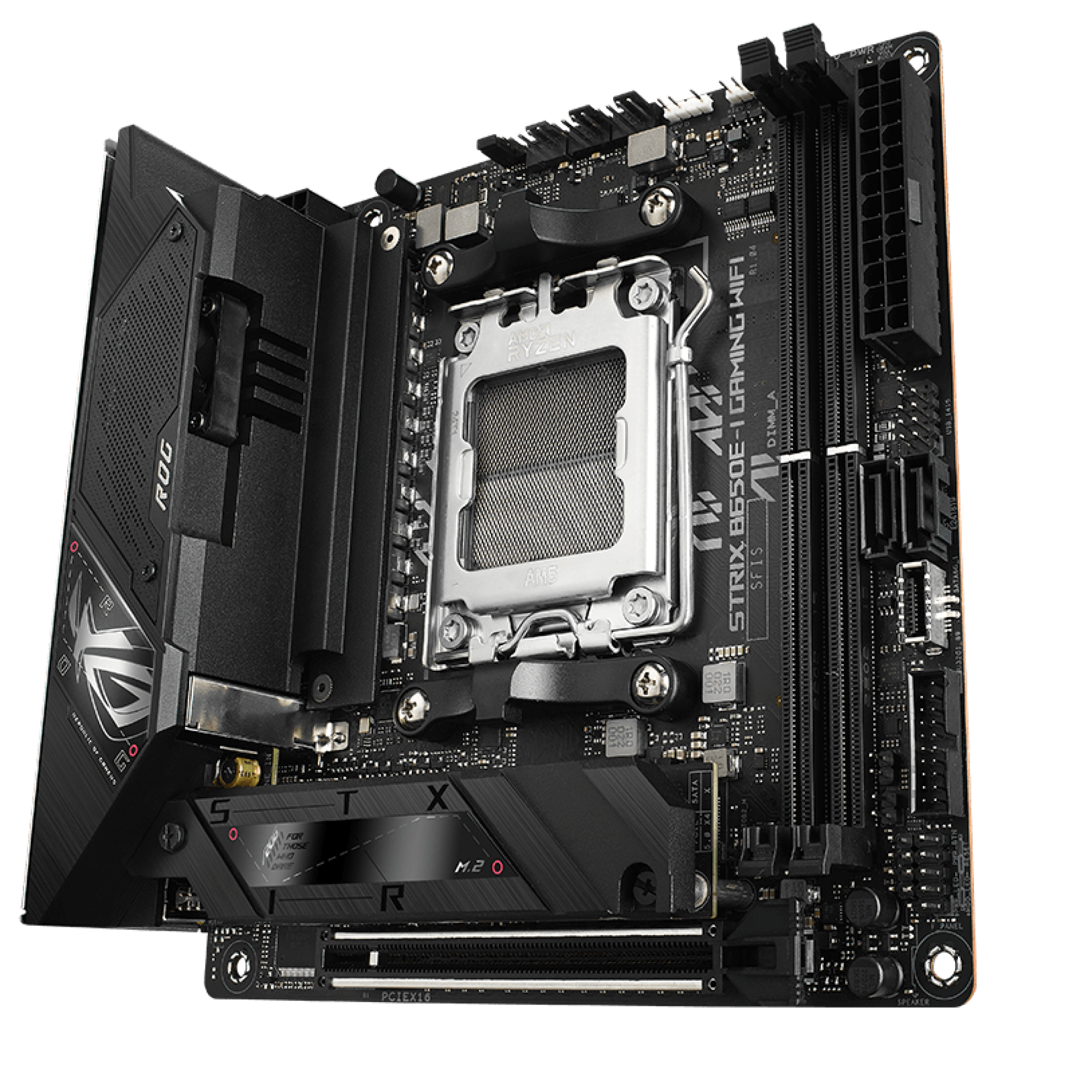
Asus ROG Strix B650E-I
This ITX motherboard delivers a good balance between price and features
The Asus ROG Strix B650E-I is an ITX motherboard that packs lots of features in a small size: PCIe 5.0 for graphics, two M.2 slots, and plenty of rear I/O for pretty much anything. Its small 10-stage VRM prevents it from running a Ryzen CPU at full bore, but mini-ITX builds often limit performance regardless.
- Relatively good 10+2 stage VRM
- PCIe 5.0 support for SSDs and GPUs
- Support for fast 6400MHz DDR5 RAM
- Expensive even for ITX, and only has a midrange chipset
I've always been a fan of Mini-ITX motherboards as they're great for creating more compact PC builds. The Asus ROG Strix B650E-I is a strong contender, rocking PCIe 5.0 on both the x16 slot and the primary M.2 slot and not costing a fortune for the luxury. It also has a 10+2 stage VRM, and while that is pretty low, ITX machines tend to run lower-wattage CPUs anyway, especially since this board only has an 8-pin plug for CPU power. Support for DDR5-6400 will at least help the CPU perform the best it can, and yes, you can install a Ryzen 9 chip on this thing.
This board is pretty good for an AMD AM5 Mini-ITX motherboard, but there are limitations. Perhaps its eight USB ports aren't quite enough, but five of them run at 3.2 Gen 2 speeds, and one of them has the superfast 3.2 Gen 2x2 spec. The 2.5 gigabit Ethernet is powered by an Intel NIC, which is a big plus. You're going to run into issues with Mini-ITX boards for connectivity and expansion support, no matter which you end up choosing. That's simply the nature of the smaller PCB dimensions. There are other ITX boards available. Asus has the even higher-end ROG Strix X670E-I, but the only things it brings to the table are two USB4 ports and an add-in card that has extra ports for internal connections.
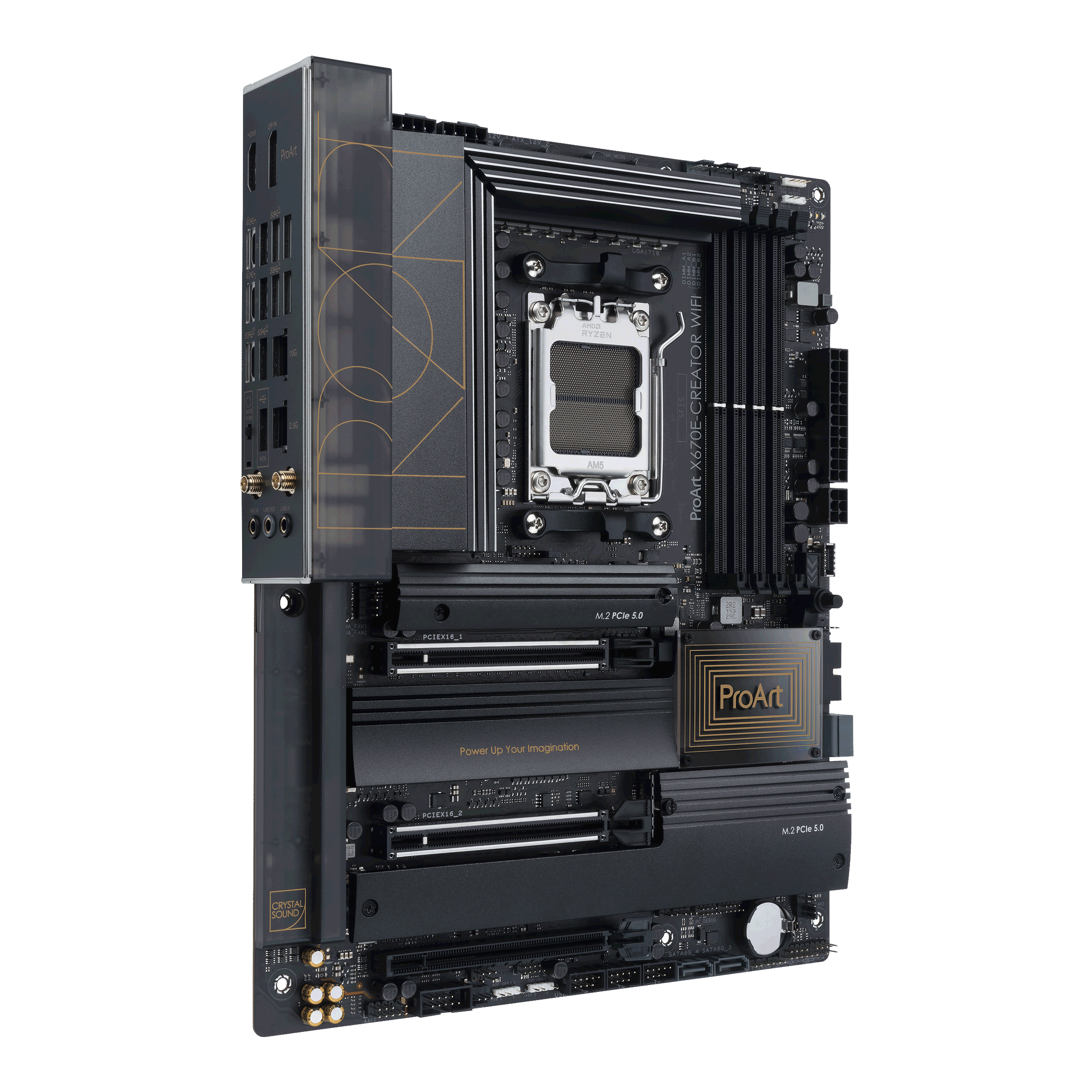
Asus ProArt X670E-Creator
A motherboard with a ridiculous amount of ports and connections
The Asus ProArt X670E-Creator is specifically made for professionals and creators who need high-end hardware. Equipped with four M.2 slots for SSDs, a pair of PCIe 5.0 enabled x16 slots for graphics, and a large VRM, this board can handle basically anything.
- Large 16+2 stage VRM
- PCIe 5.0 GPU slot and two PCIe 5.0 M.2 slots for SSDs
- Superb rear I/O full of high-performance ports
- Expensive
Although AMD's Threadripper CPUs are made for productivity and usage on workstations, nothing is stopping you from using a Ryzen CPU instead, and unless you need lots of RAM, AM5 can be a great platform for a workstation PC. If you're building a PC for work, we recommend Asus's ProArt X670E-Creator, which is a no-compromises board. This motherboard has it all: two PCIe x16 slots running at 5.0 (if both are populated, they drop to half lanes, which is effectively PCIe 4.0 speeds), four M.2 slots with two running at PCIe 5.0 and the others at 4.0, and support for DDR5-6400 and DDR5-4800 ECC RAM.
The VRM uses 16+2 stages, which is lower than many other X670E boards but still sufficient for high-end CPUs. Each M.2 SSD slot comes with a heatsink. The rear I/O is extremely impressive with its 10 gigabit and 2.5 gigabit Ethernet ports and two USB4 ports, plus nine other USB ports. The ProArt X670E-Creator is essentially unrivaled for workstation use, particularly thanks to its ECC memory support. However, if you aren't going to be using ECC memory, ASRock's X670E Taichi Carrara might be a viable alternative. It has a larger 24+2 stage VRM, more SATA ports, and the same number of M.2 and USB4 slots but lacks 10 gigabit Ethernet and support for ECC RAM.
Final thoughts on choosing the best AM5 motherboard
Ryzen 7000 and AM5 are, on the one hand, packed full of brand-new technology, but on the other hand, are significantly more expensive than what we're used to seeing. Of all these motherboards, the one I like the most overall is Asus ROG Strix X670E-E Gaming, which is one of the best AM5 motherboards in terms of features without being too much. It's largely overkill for many PC builds, which is where my other recommendations come into play, but if you can afford it, you'll have a great PC.
For the best value, I'd go for the ASRock B650E Taichi. It has an impressive 24+2+1 stage VRM for stable system overclocking, one PCIe 5.0 M.2 slot in addition to two more PCIe 4.0 M.2 slots, 12 USB 3.2 ports, and Intel Ethernet and Wi-Fi. It has it all without costing too much. The best part about buying an AM5 motherboard is the platform is still young, meaning you'll be able to keep the same board for future Ryzen generations and upgrade without building a brand-new system.

Asus ROG Strix X670E-E Gaming
The Asus ROG Strix X670E-E Gaming is a high-end Asus motherboard that supports PCIe 5.0 graphics, three PCIe 5.0 SSDs, and high-end Ryzen 7000 CPUs thanks to its large 18+2 stage VRM.

